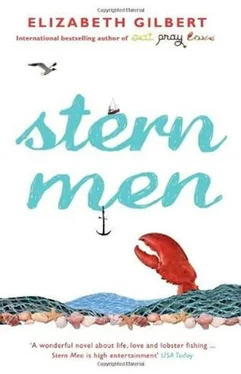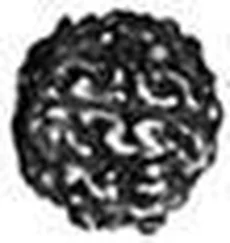
Elizabeth Gilbert
Stern Men
© 2000
To Sarah Chalfant.
For everything.
In an aquarium at Woods Hole in the summer of 1892, a conch was placed in the same tank with a female lobster, which was nearly ten inches long, and which had been in captivity about eight weeks. The conch, which was of average size, was not molested for several days, but at last, when hard pressed by hunger, the lobster attacked it, broke off its shell, piece by piece, and made quick work of the soft parts.
– The American Lobster: A Study of Its Habits and Development Francis Hobart Herrick, Ph.D., 1895
TWENTY MILES out from the coast of Maine, Fort Niles Island and Courne Haven Island face off-two old bastards in a staring contest, each convinced he is the other’s only guard. Nothing else is near them. They are among nobody. Rocky and potato-shaped, they form an archipelago of two. Finding these twin islands on a map is a most unexpected discovery; like finding twin towns on a prairie, twin encampments on a desert, twin huts on a tundra. So isolated from the rest of the world, Fort Niles Island and Courne Haven Island are separated from each other by only a fast gut of seawater, known as Worthy Channel. Worthy Channel, nearly a mile wide, is so shallow in parts at low tide that unless you knew what you were doing-unless you really knew what you were doing-you might hesitate to cross it even in a canoe.
In their specific geography, Fort Niles Island and Courne Haven Island are so astonishingly similar that their creator must have been either a great simpleton or a great comic. They are almost exact duplicates. The islands-the last peaks of the same ancient, sunken mountain chain-are made from the same belt of quality black granite, obscured by the same cape of lush spruce. Each island is approximately four miles long and two miles wide. Each has a handful of small coves, a number of freshwater ponds, a scattering of rocky beaches, a single sandy beach, a single great hill, and a single deep harbor, held possessively behind its back, like a hidden sack of cash.
On each island, there is a church and a schoolhouse. Down by the harbor is a main street (called, on each island, Main Street), with a tiny cluster of public buildings-post office, grocer, tavern. There are no paved roads to be found on either island. The houses on the islands are much alike, and the boats in the harbors are identical. The islands share the same pocket of interesting weather, significantly warmer in the winter and cooler in the summer than any coastal town, and they often find themselves trapped within the same spooky bank of fog. The same species of fern, orchid, mushroom, and wild rose can be found on both islands. And, finally, these islands are populated by the same breeds of birds, frogs, deer, rats, foxes, snakes, and men.
The Penobscot Indians left the first human records on Fort Niles and Courne Haven. They found the islands an excellent source of sea fowl eggs, and the ancient stone weapons of these early visitors still show up in certain coves. The Penobscot didn’t long remain so far out in the middle of the sea, but they did use the islands as temporary fishing stations, a practice picked up handily in the early seventeenth century by the French.
The first permanent settlers of Fort Niles and Courne Haven were two Dutch brothers, Andreas and Walter Van Heuvel, who, after taking their wives and children and livestock out to the islands in June of 1702, laid claim to one island for each family. They called their settlements Bethel and Canaan. The foundation of Walter Van Heuvel’s home remains, a moss-covered pile of rock in a meadow on what he called Canaan Island-the exact site, in fact, of Walter’s murder at the hands of his brother just one year into their stay. Andreas also killed Walter’s children on that day and took his brother’s wife over to Bethel Island to live with his family. Andreas was frustrated, it is said, that his own wife was not bearing him children fast enough. Eager for more heirs, he’d set out to claim the only other woman around. Andreas Van Heuvel broke his leg some months later, while building a barn, and he died from an ensuing infection. The women and children were soon rescued by a passing English patrol ship and taken to the stockade at Fort Pemaquid. Both women were pregnant at the time. One delivered a healthy son, whom she named Niles. The other woman’s child died in delivery, but the mother’s life was saved by Thaddeus Courne, an English doctor. Somehow this event gave rise to the names of the two islands: Fort Niles and Courne Haven-two very pretty places that would not be settled again for another fifty years.
The Scots-Irish came next, and they stayed. One Archibald Boyd, along with his wife, his sisters, and their husbands, took over Courne Haven in 1758. They were joined during the next decade by the Cobbs, Pommeroys, and Strachans. Duncan Wishnell and his family started a sheep farm on Fort Niles in 1761, and Wishnell soon found himself surrounded by neighbors called Dalgleish, Thomas, Addams, Lyford, Cardoway, and O’Donnell, as well as some Cobbs who’d moved over from Fort Niles. The young ladies of one island married the young men of the other, and the family names began floating back and forth between the two places like loose buoys. By the mid-1800s, new names appeared, from new arrivals: Friend, Cashion, Yale, and Cordin.
These people shared much the same ancestral background. And because there were not many of them out there, it’s not surprising that, in time, the inhabitants came to resemble one another more and more. Rampant intermarriage was the culprit. Fort Niles and Courne Haven somehow managed to avoid the fate of Malaga Island, whose population became so inbred that the state had to finally step in and evacuate everyone, but the blood lines were still extremely thin. In time, there developed a distinctive form (short, tightly muscled, sturdy) and face (pale skin, dark brows, small chin), which came to be associated with both Courne Haven and Fort Niles. After several generations, it could be fairly said that every man looked like his neighbor and every woman would have been recognized by her ancestors on sight.
They were all farmers and fishermen. They were all Presbyterians and Congregationalists. They were all political conservatives. During the Revolutionary War, they were colonial patriots; during the Civil War, they sent young men in blue wool jackets to fight for the Union in distant Virginia. They did not like to be governed. They did not like to pay taxes. They did not trust experts, and they were not interested in the opinions or the appearance of strangers. Over the years, the islands were, on different occasions and for various reasons, incorporated into several inland counties, one after another. These political mergers never ended well. Each arrangement ultimately became unsatisfactory to the islanders, and by 1900 Courne Haven and Fort Niles were left to form an independent township. Together, they created the tiny domain of Skillet County. But that, too, was a temporary arrangement. In the end, the islands themselves split; the men on each island, it seemed, felt best and safest and most autonomous when left completely alone.
The population of the islands continued to grow. Toward the end of the nineteenth century, there came a muscular expansion, with the advent of the granite trade. A young New Hampshire industrialist named Dr. Jules Ellis brought his Ellis Granite Company to both islands, where he soon made a fortune by excavating and selling the glossy black rock.
Читать дальше










